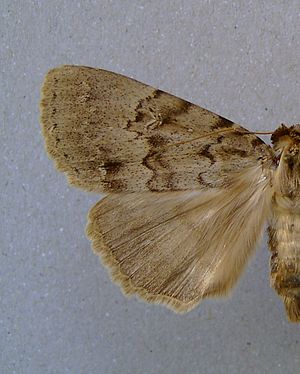Apopestes spectrum
| Apopestes spectrum | ||||||||||||
|---|---|---|---|---|---|---|---|---|---|---|---|---|

Apopestes spectrum |
||||||||||||
| Systematics | ||||||||||||
|
||||||||||||
| Scientific name | ||||||||||||
| Apopestes spectrum | ||||||||||||
| ( Esper , 1787) |
Apopestes spectrum , sometimes also referred to as the great gorse owl , is a butterfly ( moth ) from the family of the owl butterflies (Noctuidae).
features
butterfly
The wingspan of the strikingly large moth is 74 to 82 millimeters. Light brown colors are predominant on the forewings . The transverse lines are dark brown, strongly wavy and partially interrupted. There is a dark spot in the post-fiscal region near the inner edge. Flaws are small, sometimes inconspicuous. The hind wings without drawing are pale brown in color.
Caterpillar, pupa
Adult caterpillars are slender and yellow in color. On each side two black and green side stripes can be seen. Below these stripes are irregular, black dots and spots. A broad, dark longitudinal line runs over the legs, the yellow or white drawing elements of which sometimes resemble the number 8 and the letter o. The head is whitish and has black spots.
The black-brown doll shows two very short bristles on the pointed cremaster .
Similar species
On the surface, especially because of the comparable size of the butterflies, a distant similarity to the Black Order Ribbon ( Mormo maura ) can be discerned, which, however, is clearly differentiated by the black central field on the forewings and the black fringe on the hind wings.
Geographical distribution and habitat
Apopestes spectrum is common in Europe in the Mediterranean area including the Mediterranean islands of Corsica , Sardinia , Sicily and Crete . Other occurrence areas include North Africa , Iran and Turkmenistan . In the valleys of the Southern Alps , the animals rise to a height of around 800 meters. The species is mainly to be found in warm places, for example on poor lawns or bush landscapes with gorse vegetation.
Way of life
In spring, the nocturnal moths like to visit bait on which they sometimes appear in numbers. However , they rarely seek out artificial light sources . They hatch in July, hibernate and then live until March of the following year. Caves, sheds or other well-protected places are chosen as wintering quarters. The caterpillars develop from April and pupate in June. To do this, you create a light, whitish, silky, shiny web between branches and leaves. Various types of gorse ( Genista ) serve as fodder plants .
swell
Individual evidence
- ↑ a b c Barry Goater, Lázló Ronkay, Michael Fibiger: Catocalinae & Plusiinae . In: Martin Honey, Michael Fibiger (eds.): Noctuidae Europaeae . tape 10 . Entomological Press, Sorø 2003, ISBN 87-89430-08-5 (English).
- ^ A b Walter Forster , Theodor A. Wohlfahrt : The butterflies of Central Europe. Volume 4: Owls. (Noctuidae). Franckh'sche Verlagshandlung, Stuttgart 1971, ISBN 3-440-03752-5 .
literature
- Barry Goater, Lázló Ronkay, Michael Fibiger: Catocalinae & Plusiinae . In: Martin Honey, Michael Fibiger (eds.): Noctuidae Europaeae . tape 10 . Entomological Press, Sorø 2003, ISBN 87-89430-08-5 (English).
Web links
- Lepiforum eV photos
- www.pyrgus.de Butterfly and ecology
- www.lepidoptera.pl Occurrence in Europe
- Apopestes spectrum at Fauna Europaea. Retrieved December 1, 2011